
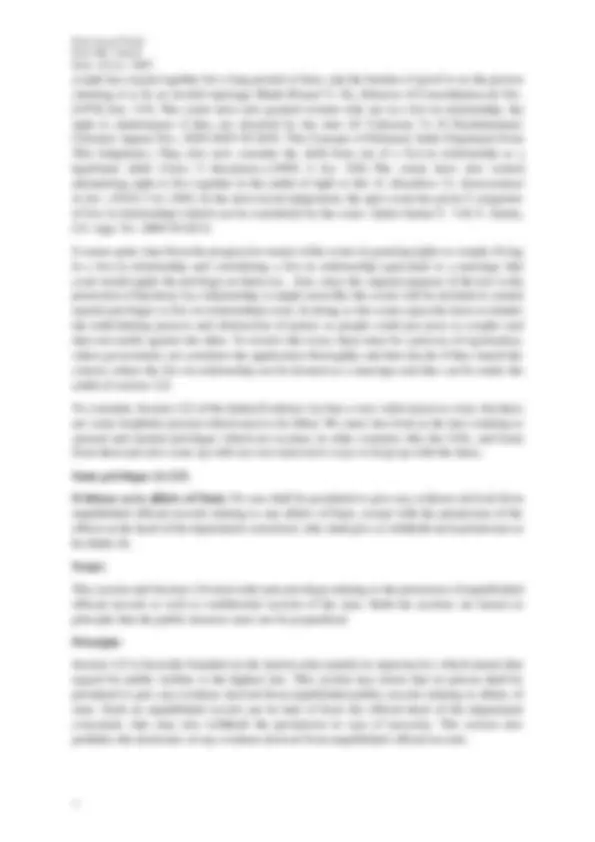
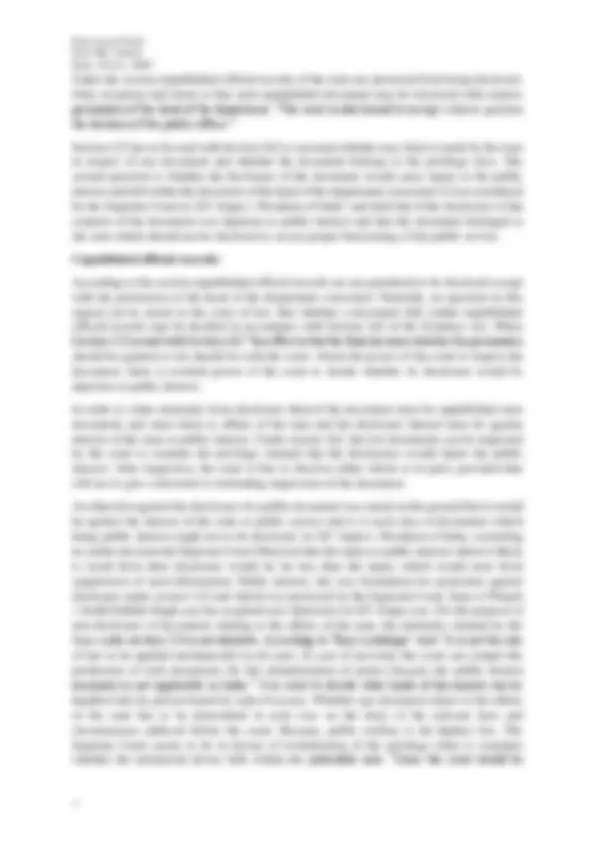
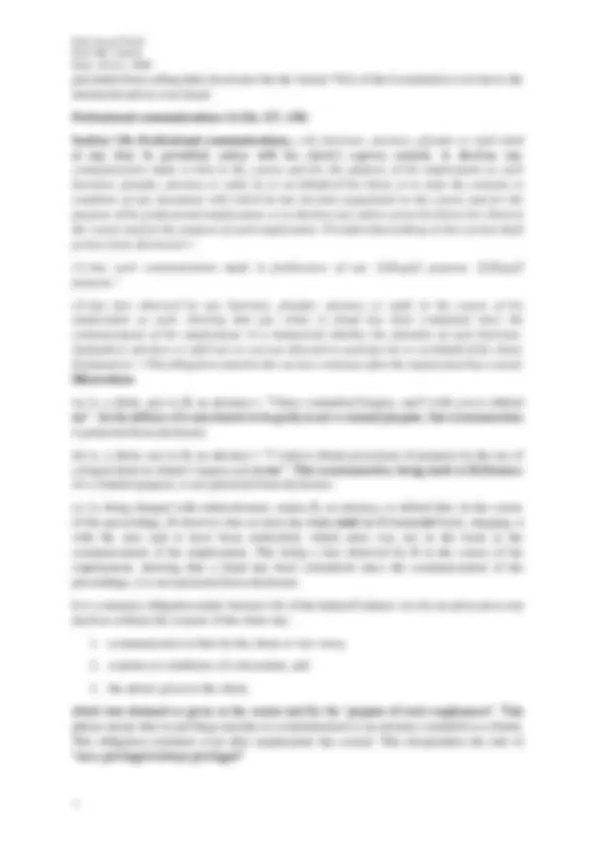
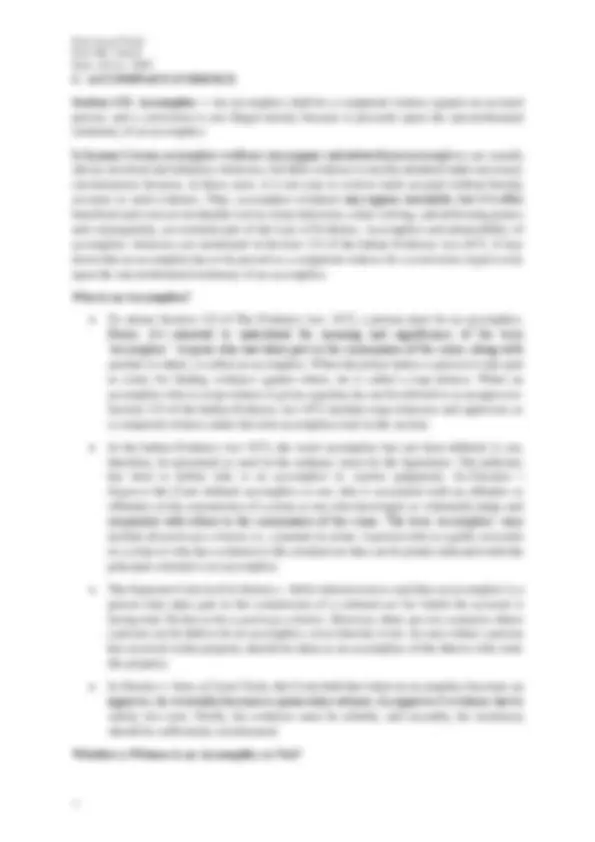
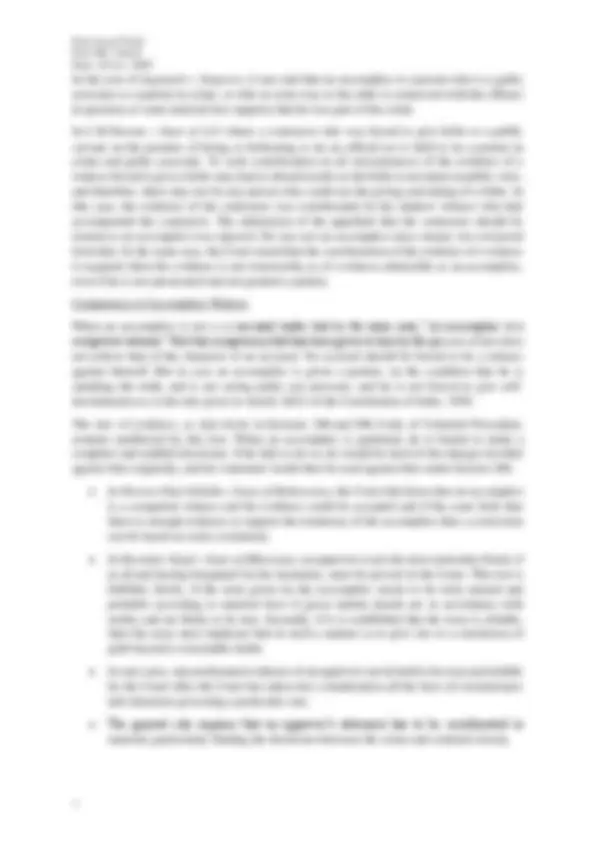
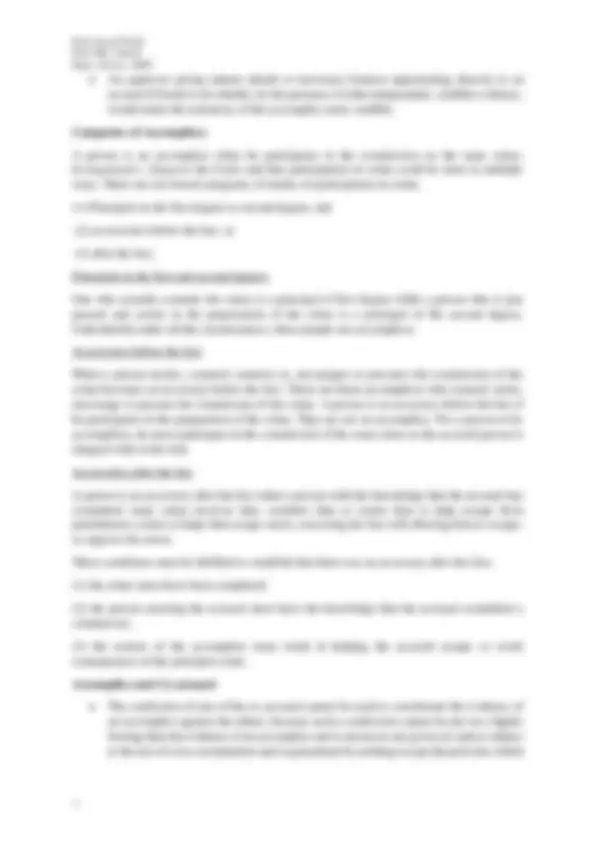
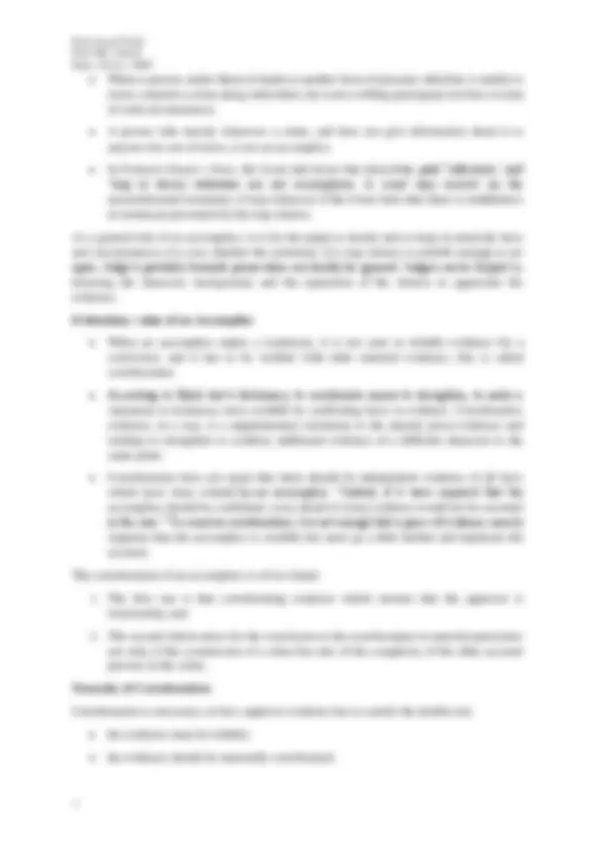
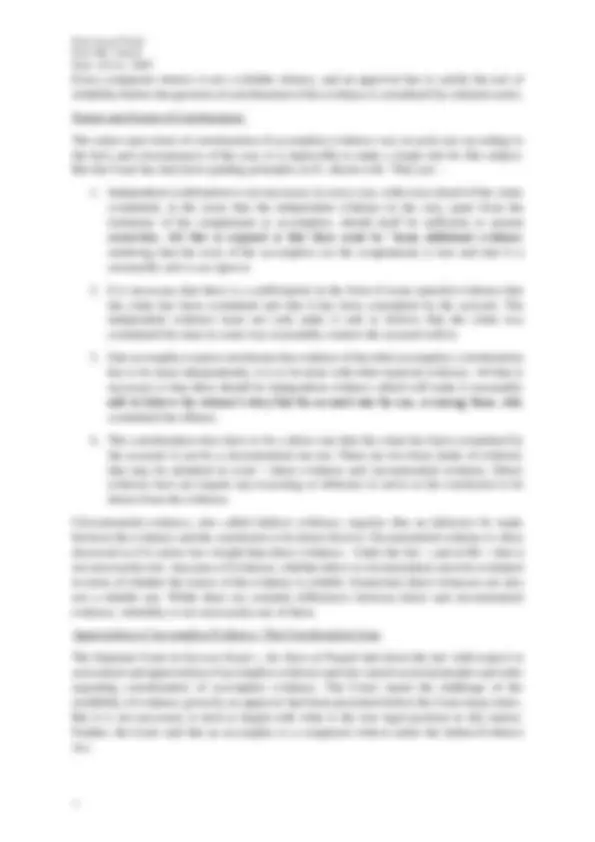
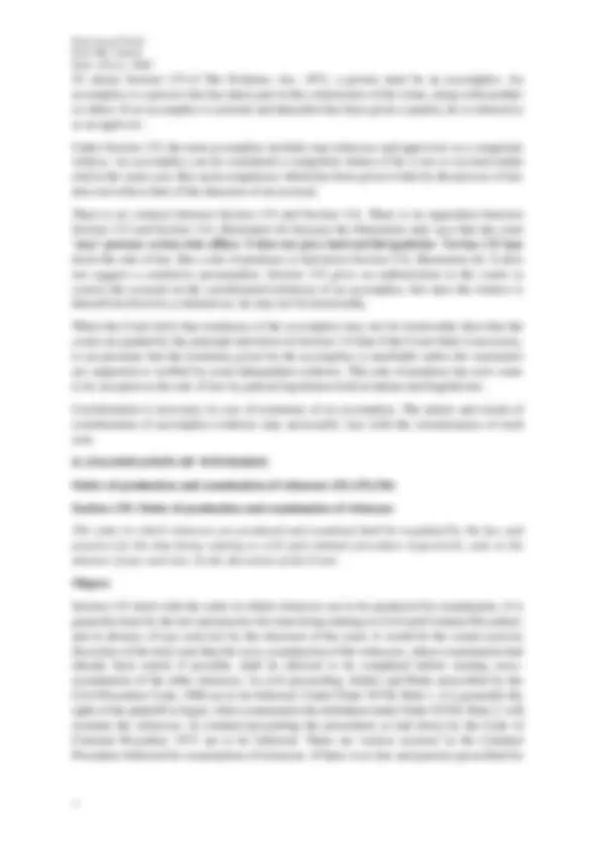
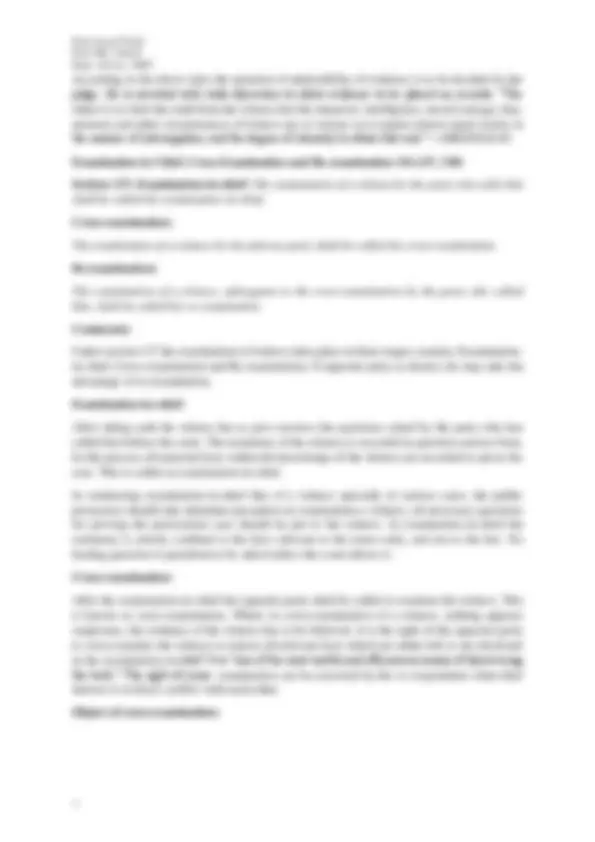
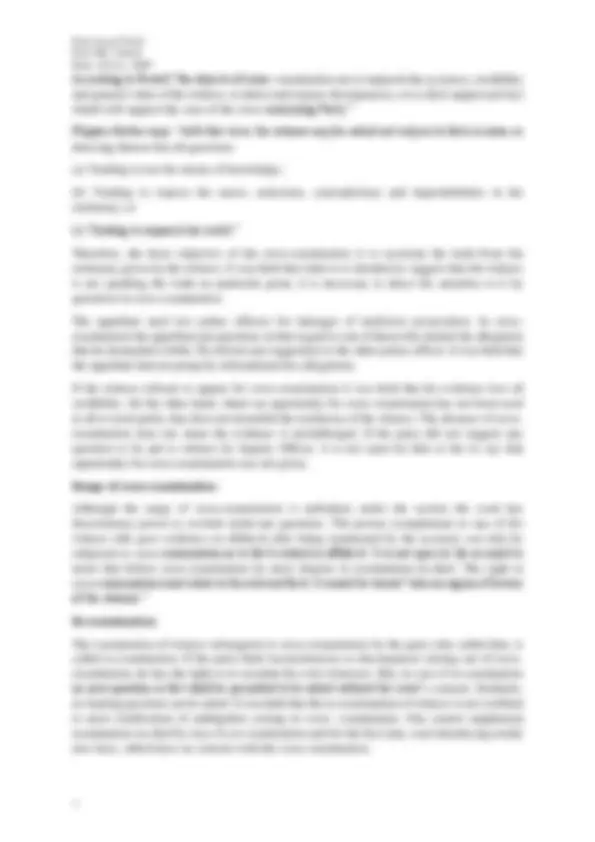
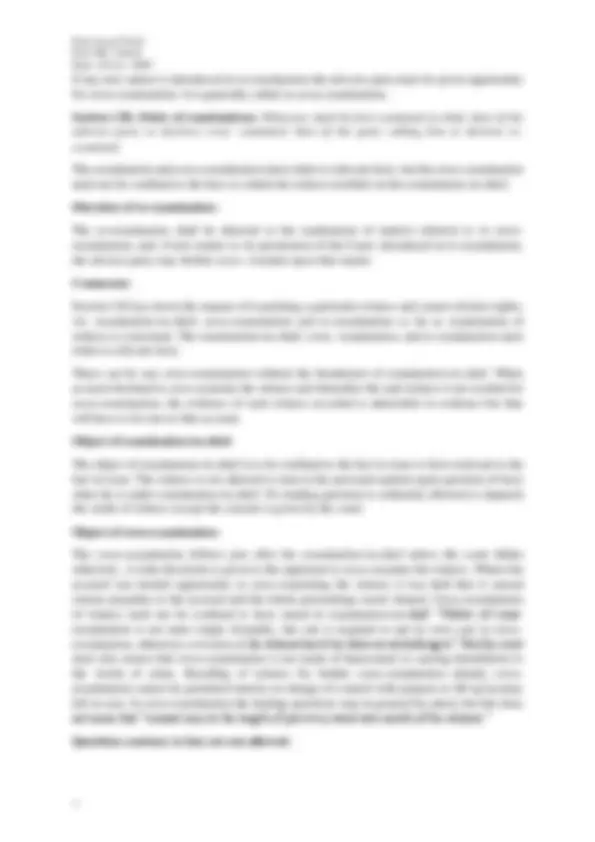
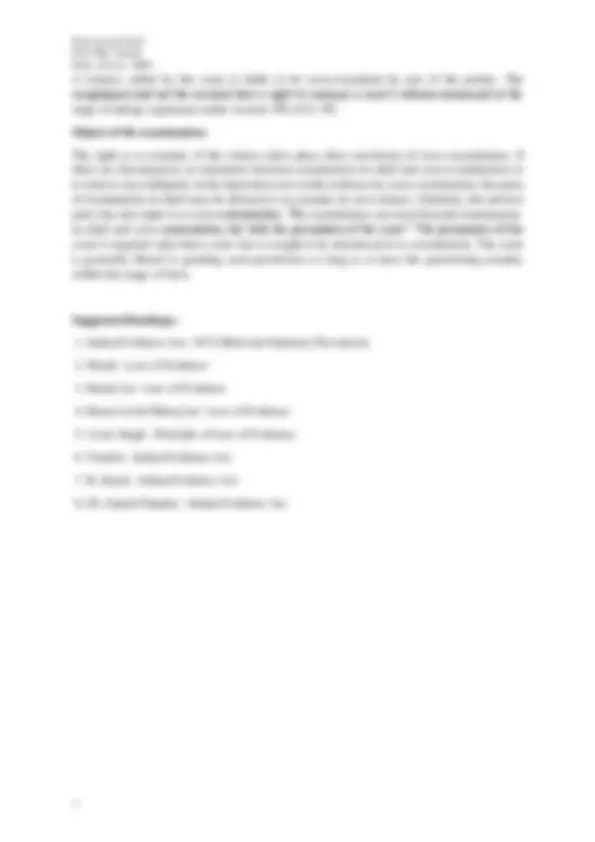


Study with the several resources on Docsity

Earn points by helping other students or get them with a premium plan


Prepare for your exams
Study with the several resources on Docsity

Earn points to download
Earn points by helping other students or get them with a premium plan
Community
Ask the community for help and clear up your study doubts
Discover the best universities in your country according to Docsity users
Free resources
Download our free guides on studying techniques, anxiety management strategies, and thesis advice from Docsity tutors
The legal provisions regarding state privileges and the use of unpublished official records as evidence in Indian law. It also covers the role of accomplice evidence, the importance of corroboration, and the examination and cross-examination of witnesses. insights into the Indian Criminal Procedure Code and case laws.
Typology: Essays (university)
1 / 21

This page cannot be seen from the preview
Don't miss anything!














Prof. Md. Ashraf Dept. of Law, AMU Study Material Law of Evidence- II B.A.LL. B (HONS) VI SEMESTER Unit- 4 A. PRIVILEGED COMMUNICATIONS Communication during marriage (S.122) Privileged communication is a kind of information which cannot be admitted in a court of law as evidence due to the nature of the relationship the two persons involved in the communication share. There are three types of privileged communications, namely, spousal privilege, attorney- client privilege and state privilege. This paper will analyse spousal privilege which is protected under section 122 of the Indian Evidence Act, 1872, and the position of the same in the USA. Section 122 of the Indian Evidence Act reads as follows- Communications during marriage. — “ No person who is or has been married, shall be compelled to disclose any communication made to him during marriage by any person to whom he is or has been married; nor shall he be permitted to disclose any such communication, unless the person who made it, or his representative in interest, consents, except in suits between married persons, or proceedings in which one married person is prosecuted for any crime committed against the other.” Marital privilege or spousal privilege seems to have originated from common law jurisprudence. The fundamental principle behind this privilege is mentioned in the case of S.J. Choudhary vs The State , which was decided on 26 July 1984, where Justice Khanna observes- “So much of the happiness of human life may fairly be said to depend on the inviolability of domestic confidence that the alarm and unhappiness occasioned to society by invading its sanctity and compelling the public disclosure of confidential communications between husband and wife would be a far greater evil than the disadvantage which may occasionally arise from the loss light which such revelations might throw on the questions in dispute hence all communications between them should be held privileged.” (S.J. Choudhary vs The State 1985 Crile 622) This concept is again echoed in English cases of Pringle v Pringle and Mercer v State. Thus, marital privilege exists because it is essential to preserve amity and sustain full confidence between a husband and a wife, therefore deeming the relationship of marriage as a sacrosanct institution and to some extent placing it above the concerns of justice. The alternate origin of this law can be traced back to the medieval times when the wife was considered to be the property of the husband and the concept of husband and the wife being a single entity was prevalent. The US supreme court in Trammel v. United States 445 U.S. 40 observed- “Spousal testimony privilege sprang from two canons of medieval jurisprudence: first, the rule that an accused was not permitted to testify in his own behalf because of his interest in the proceeding; second, the concept that husband and wife were one, and that since the woman had no recognised separate legal existence, the husband was that one. From those two now long-
Prof. Md. Ashraf Dept. of Law, AMU abandoned doctrines, it followed that what was inadmissible from the lips of the defendant- husband was also inadmissible from his wife.” They interpreted wife as a belonging of the husband, and not another human being with an identity of her own, and since self-incrimination does not lead to conviction and is not admissible in the court, the idea was that a person’s property cannot testify against the owner of the property, and because the wife was indistinguishable from the husband, any incriminatory statement by the wife against the husband would be considered self- incriminatory. Section 122 of the Indian Evidence Act protects every communication between the spouses, during the time of marriage, and prevents it from being brought to court as evidence. Although, section 122 of the Indian Evidence Act may seem to be very rigid at a first look, but it has some exceptions to it, such as not protecting the spouse if the spouse is accused of an offence against the other spouse. The Supreme Court has also held that section 122 will be applied to every communication made during the life of marriage and the same privilege will continue even after separation or divorce or dissolution of the marital relation, but only for the communication which was made during the existence of marriage ( M.C. Vergliese V T.J. Ponnam Air 1967 Ker 228 ). It also allows the conduct influenced by the communication, or the spouse witnessing the other spouse doing a criminal act, to be admitted as evidence in the courts, i.e. an effect of the communication can be brought to court but not the communication itself (Bhalchandra Namdeo Shinde Vs. The State of Maharashtra 2003(2) Mhlj 580). Therefore, the conclusion that can be reached to, is that marital privilege exists because of the relationship of marriage being considered the foundation of the society and it is vital to protect the intimate relationship of a husband and wife. One of my concerns with the law that currently is in place is that the courts don’t look at the motive behind the marriage or the stability of the marriage. According to me, these are important factors to look at before not allowing evidence under section 122. As the intent of the legislation was to protect the harmony in a relationship, so a relationship which is already non-harmonious should not be considered under this section. The position in the United States of America on spousal privilege is different from that in India. Spousal privilege in USA, is divided into two kinds of privilege, namely the marital confidences privilege and the spousal testimonial privilege. The marital confidences privilege does not allow the testimony to come in as evidence and directly disqualifies it whereas spousal testimonial privilege allows the testimony of the defendant’s spouse to come in as evidence only if the spouse of the accused wants to, but it does not allow the defendant to prevent the spouse from testifying. This classification is important as even though courts cannot compel a spouse to testify against the other spouse but if the spouse wants to testify, he/she can and it benefits the truth finding process. In 1995, it was held in the case of United States v. Acker that marital privilege only applies to people who are legally married and not to people who are cohabiting without a legal marriage. But now after twenty-three years, with both the Indian as well as the English courts numerous rights being conferred upon people who are in a live-in relationship, this privilege could be extended to those relationships. In live-in relationships, the level of intimacy is at the level of that of a marital relationship, but the only thing lacking is a valid marriage in the eyes of law. Indian courts of law have recognised live-in relationship to be a valid marriage if the
Prof. Md. Ashraf Dept. of Law, AMU Under the section unpublished official records of the state are protected from being disclosed. Only exception laid down is that such unpublished document may be disclosed with express permission of the head of the department. “The court is also bound to accept without question the decision of the public officer.” Section 123 has to be read with Section 162 to ascertain whether any claim is made by the state in respect of any document and whether the document belongs to the privilege class. The second question is whether the disclosure of the document would cause injury to the public interest and fall within the discretion of the head of the department concerned. It was considered by the Supreme Court in S.P. Gupta v President of India^1 and held that if the disclosure of the contents of the document was injurious to public interest and that the document belonged to the state which should not be disclosed to secure proper functioning of the public service. Unpublished official records: According to the section unpublished official records are not permitted to be disclosed except with the permission of the head of the department concerned. Naturally, no question in this regard can be raised in the court of law. But whether a document falls within unpublished official records may be decided in accordance with Section 162 of the Evidence Act. When Section 123 is read with Section 162 “the effect is that the final decision whether the permission should be granted or not should be with the court. About the power of the court to inspect the document, there is residual power of the court to decide whether its disclosure would be injurious to public interest. In order to claim immunity from disclosure thereof the document must be unpublished state documents and must relate to affairs of the state and the disclosure thereof must be against interest of the state or public interest. Under section 162, the rest documents can be inspected by the court to examine the privilege claimed that the disclosures would injure the public interest. After inspection, the court is free to disclose either whole or in parts, provided that will not to give a distorted or misleading impression of the document. An objection against the disclosure of a public document was raised on the ground that it would be against the interest of the state or public service and it is such class of documents which being public interest ought not to be disclosed. In S.P. Gupta v President of India, overruling its earlier decision the Supreme Court Observed that the injury to public interest which is likely to result from their disclosure would be far less than the injury which would arise from suppression of such information. Public interest, the very foundation for protection against disclosure under section 123 and which was protected by the Supreme Court. State of Punjab v Sodhi Sukhde Singh case has acquired new dimension in S.P. Gupta case. For the purpose of non-disclosure of documents relating to the affairs of the state, the immunity claimed by the State under section 123 is not absolute. According to Their Lordships’ view “it is not the rule of law to be applied mechanically in all cases. In case of necessity the court can compel the production of such documents for fair administration of justice because the public interest immunity is not applicable in India.” It is court to decide what kinds of documents can be handled only by person bound by oath of secrecy. Whether any document relates to the affairs of the state has to be determined in each case on the basis of the relevant facts and circumstances adduced before the court. Because, public welfare is the highest law. The Supreme Court seems to be in favour of revitalization of the privilege when it considers whether the ministerial advice falls within the justiciable area. “Since the court would be
Prof. Md. Ashraf Dept. of Law, AMU precluded from calling their disclosure but the Article 74(2) of the Constitution is no bar to the ministerial advice was based. Professional communications (S.126, 127, 128) Section 126. Professional communications.— No barrister, attorney, pleader or vakil shall at any time be permitted, unless with his client’s express consent, to disclose any communication made to him in the course and for the purpose of his employment as such barrister, pleader, attorney or vakil, by or on behalf of his client, or to state the contents or condition of any document with which he has become acquainted in the course and for the purpose of his professional employment, or to disclose any advice given by him to his client in the course and for the purpose of such employment: Provided that nothing in this section shall protect from disclosure— (1) Any such communication made in furtherance of any 1[illegal] purpose; 2[illegal] purpose;" (2) Any fact observed by any barrister, pleader, attorney or vakil, in the course of his employment as such, showing that any crime or fraud has been committed since the commencement of his employment. It is immaterial whether the attention of such barrister, 2[pleader], attorney or vakil was or was not directed to such fact by or on behalf of his client. Explanation. —The obligation stated in this section continues after the employment has ceased. Illustrations (a) A, a client, says to B, an attorney— “I have committed forgery, and I wish you to defend me”. As the defence of a man known to be guilty is not a criminal purpose, this communication is protected from disclosure. (b) A, a client, says to B, an attorney— “I wish to obtain possession of property by the use of a forged deed on which I request you to sue”. This communication, being made in furtherance of a criminal purpose, is not protected from disclosure. (c) A, being charged with embezzlement, retains B, an attorney, to defend him. In the course of the proceedings, B observes that an entry has been made in A’s account-book, charging A with the sum said to have been embezzled, which entry was not in the book at the commencement of his employment. This being a fact observed by B in the course of his employment, showing that a fraud has been committed since the commencement of the proceedings, it is not protected from disclosure. It is a statutory obligation under Section 126 of the Indian Evidence Act for an advocate to not disclose without the consent of the client any-
Prof. Md. Ashraf Dept. of Law, AMU he shall be deemed to have consented to such disclosure only if he questions such barrister, attorney or vakil on matters which, but for such question, he would not be at liberty to disclose. Principle: Section 128 may be regarded as other exception to Section 126 or it is the supplement to Section
Prof. Md. Ashraf Dept. of Law, AMU C. ACCOMPLICE EVIDENCE Section 133. Accomplice —An accomplice shall be a competent witness against an accused person; and a conviction is not illegal merely because it proceeds upon the uncorroborated testimony of an accomplice. In layman’s terms, accomplice evidence may appear untrustworthy as accomplices are usually always involved and infamous witnesses, but their evidence is mostly admitted under necessary circumstances because, in these cases, it is not easy to convict main accused without having recourse to such evidence. Thus, accomplice evidence may appear unreliable, but it’s often beneficial and even an invaluable tool in crime detection, crime-solving, and delivering justice and consequently, an essential part of the Law of Evidence. Accomplice and admissibility of accomplice witnesses are mentioned in Section 133 of the Indian Evidence Act,1872. It lays down that an accomplice has to be proved as a competent witness for a conviction, legal to rely upon the uncorroborated testimony of an accomplice. Who is an Accomplice? To attract Section 13 3 of The Evidence Act, 1872, a person must be an accomplice. Hence, it’s essential to understand the meaning and significance of the term ‘accomplice.’ Anyone who has taken part in the commission of the crime, along with another or others, is called an accomplice. When the police induce a person to take part in crime for finding evidence against others, he is called a trap-witness. When an accomplice who is a trap-witness is given a pardon, he can be referred to as an approver. Section 133 of the Indian Evidence Act 1872 includes trap witnesses and approvers as a competent witness under the term accomplice used in the section. In the Indian Evidence Act 1872, the word accomplice has not been defined; it can, therefore, be presumed as used in the ordinary sense by the legislature. The judiciary has tried to define who is an accomplice in various judgments. In Chandan v Emperor the Court defined accomplice as one who is associated with an offender or offenders in the commission of a crime or one who knowingly or voluntarily helps and cooperates with others in the commission of the crime. The term ‘accomplice’ may include all particeps criminis i.e., a partner in crime. A person who is a guilty associate in a crime or who has a relation to the criminal act that can be jointly indicated with the principal criminal is an accomplice. The Supreme Court in R.K Dalmia v. Delhi Administration said that an accomplice is a person who takes part in the commission of a criminal act for which the accused is facing trial. He has to be a particeps criminis. However, there are two scenarios where a person can be held to be an accomplice, even when he is not. In cases where a person has received stolen property should be taken as an accomplice of the thieves who stole the property. In Shanker v State of Tamil Nadu , the Court held that when an accomplice becomes an approver, he eventually becomes a prosecution witness. An approver’s evidence has to satisfy two tests. Firstly, his evidence must be reliable, and secondly, his testimony should be sufficiently corroborated. Whether a Witness is an Accomplice or Not?
Prof. Md. Ashraf Dept. of Law, AMU An approver giving minute details or necessary features appertaining directly to an accused if found to be reliable, by the presence of other independent, credible evidence, would make the testimony of the accomplice more credible. Categories of Accomplices A person is an accomplice when he participates in the commission on the same crime. In Jagannath v Emperor the Court said that participation in crime could be done in multiple ways. There are two broad categories of modes of participation in crime, (1) Principals in the first degree or second degree, and (2) accessories before the fact, or (3) after the fact. Principals in the first and second degrees One who actually commits the crime is a principal of first degree while a person who is just present and assists in the perpetration of the crime is a principal of the second degree. Undoubtedly under all the circumstances, these people are accomplices. Accessories before the fact When a person incites, counsels connives at, encourages or procures the commission of the crime becomes an accessory before the fact. These are those accomplices who counsel, incite, encourage or procure the commission of the crime. A person is an accessory before the fact if he participates in the preparation of the crime. They are not an accomplice. For a person to be accomplices, he must participate in the commission of the same crime as the accused person is charged with in the trial. Accessories after the fact A person is an accessory after the fact when a person with the knowledge that the accused has committed some crime receives him, comforts him or assists him to help escape from punishment a crime or helps him escape arrest, exercising his free will allowing him to escape, or opposes his arrest. Three conditions must be fulfilled to establish that there was an accessory after the fact; (1) the crime must have been completed; (2) the person assisting the accused must have the knowledge that the accused committed a criminal act; (3) the actions of the accomplice must result in helping the accused escape or avoid consequences of the principal crime. Accomplice and Co-accused The confession of one of the co-accused cannot be used to corroborate the evidence of an accomplice against the others, because such a confession cannot be put on a higher footing than the evidence of an accomplice and is moreover not given on oath or subject to the test of cross-examination and is guaranteed by nothing except the peril into which
Prof. Md. Ashraf Dept. of Law, AMU it brings the speaker and which it is generally fashioned to lessen. Altered evidence is not made better by being corroborated by other tainted evidence. Section 30 of the Indian Evidence Act says that the Court may consider the confession of co-accused as evidence. It may be noted that the confession of the co-accused must implicate himself as well as some other accused. Further, the confessions made at the previous trial will not be relevant. When they are jointly tried, but for different offences, in those cases, confession is not relevant. Further, the confession should be a free confession. A confession by a co-accused cannot be treated in the same way as the testimony of an accomplice:
Prof. Md. Ashraf Dept. of Law, AMU When a person, under threat of death or another form of pressure which he is unable to resist, commits a crime along with others, he is not a willing participant in it but a victim of such circumstances. A person who merely witnesses a crime, and does not give information about it to anyone else out of terror, is not an accomplice. In Prakash Chand v State , the Court laid down that detectives, paid ‘informers,’ and ‘trap or decoy witnesses are not accomplices. A court may convict on the uncorroborated testimony of trap witnesses if the Court feels that there is truthfulness in testimony presented by the trap witness. As a general rule of an accomplice, it is for the judge to decide and to keep in mind the facts and circumstances of a case whether the testimony of a trap witness is reliable enough to act upon. Judge’s partiality towards prosecution can hardly be ignored. Judges can be helped by knowing the character, background, and the reputation of the witness to appreciate his evidence. Evidentiary value of an Accomplice When an accomplice makes a testimony, it is not seen as reliable evidence for a conviction, and it has to be verified with other material evidence; this is called corroboration. According to Black law’s dictionary, to corroborate means to strengthen, to make a statement or testimony more credible by confirming facts or evidence. Corroborative evidence, in a way, is a supplementary testimony to the already given evidence and tending to strengthen or confirm; additional evidence of a different character to the same point. Corroboration does not mean that there should be independent evidence of all facts which have been related by an accomplice. “Indeed, if it were required that the accomplice should be confirmed, every detail of crime evidence would not be essential in the case.” To count as corroboration, it is not enough that a piece of evidence merely supports that the accomplice is credible but must go a little further and implicate the accused. The corroboration of an accomplice is of two kinds:
Prof. Md. Ashraf Dept. of Law, AMU Every competent witness is not a reliable witness, and an approver has to satisfy the test of reliability before the question of corroboration of his evidence is considered by criminal courts. Nature and Extent of Corroboration The nature and extent of corroboration of accomplice evidence vary in each case according to the facts and circumstances of the case; it is impossible to make a single rule for this subject. But the Court has laid down guiding principles in R v Baskerville. They are: -
Prof. Md. Ashraf Dept. of Law, AMU examination of witnesses, the order by which the witnesses ought to be examined are to be determined by the court. Procedure for examination of witness: When the examination of a witness takes place, the other witnesses must be kept out of the court room. All witnesses are to be examined one by one. When any objection is raised by either of the parties the court should dispose of the objection instantly with reason in writing. In civil cases the rule governing production and examination of witnesses depend upon the principle which governs the question. It is privilege of the party who has the right to begin. “The right to begin is obviously an advantage to the party with a strong case for he gets the privilege of making the first impression.” In criminal trials the prosecution always begins. The prosecutor is required to examine the witnesses in proper order. In case of examination of expert witnesses, it ought not to be examined at the early stage of trial. Non-examination of witness: The Supreme Court in observe of record to show the efforts were made by prosecution to produce witness, held non-examination of witness on ground that the witness was untraceable to be not justifiable. The Supreme Court took note of another aspect that “one person who was to be examined on the particular date was examined earlier than the date fixed and observed that was unusual conduct by the prosecutor which have been seriously taken note of the trial court and High Court.” Police while filing charge-sheet enlisted the name of ‘M’ in list of witnesses. ‘M’ was summoned for examination. But same could not be achieved as the said witness was shifted to Hong Kong and not staying in India. It was held that it cannot be said that the witness was deliberately not examined by the prosecution. Section 136, Judge to decide as to admissibility of evidence: When either party proposes to give evidence of any fact, the Judge may ask the party proposing to give the evidence in what manner the alleged fact, if proved, would be relevant; and the Judge shall admit the evidence if he thinks that the fact, if proved, would be relevant, and not otherwise. If the fact proposed to be proved is one of which evidence is admissible only upon proof of some other fact, such last-mentioned fact must be proved before evidence is given of the fact first mentioned, unless the party undertakes to give proof of such fact, and the Court is satisfied with such undertaking. If the relevancy of one alleged fact depends upon another alleged fact being first proved, the Judge may, in his discretion, either permit evidence of the first fact to be given before the second fact is proved, or require evidence to be given of the second fact before evidence is given of the first fact. Illustrations:
Prof. Md. Ashraf Dept. of Law, AMU (a) It is proposed to prove a statement about a relevant fact by a person alleged to be dead, which statement is relevant under section 32. The fact that the person is dead must be proved by the person proposing to prove the statement, before evidence is given of the statement. (b) It is proposed to prove, by a copy, the contents of a document said to be lost. The fact that the original is lost must be proved by the person proposing to produce the copy, before the copy is produced. (c) A is accused of receiving stolen property knowing it to have been stolen. It is proposed to prove that he denied the possession of the property. The relevancy of the denial depends on the identity of the property. The Court may, in its discretion, either require the property to be identified before the denial of the possession is proved, or permit the denial of the possession to be proved before the property is identified. (d) It is proposed to prove a fact (A) which is said to have been the cause or effect of a fact in issue. There are several intermediate facts (В, С and D) which must be shown to exist before the fact (A) can be regarded as the cause or effect of the fact in issue. The Court may either permit A to be proved before В, С or D is proved, or may require proof of В, С and D before permitting proof of A. Scope: This section deals with discretions to be exercised by a judge in connection with the admissibility of evidence. As it has been seen in Section 5 of the Act the evidence can be given of only facts which is either in issue or is relevant to issues. To decide the admissibility and non-admissibility of evidence Section 136 embodies three basic rules: Rule 1: When party proposes to give evidence of any fact the judge may ask the party in what manner the alleged fact, if proved, would be relevant. The question is to be decided by the judge. If he finds that the evidence would not be relevant, he would not allow the party from proving it as because, it would only waste the time of the court. In such circumstances the court may disallow such evidence. Rule 2: If the fact proposed to be proved is one of which evidence is admissible only upon prove of another fact, the other fact must be proved before evidence of first fact is given. For example, if a person wants to prove a dying declaration, he must first prove that the declarant is dead. [Illustration (a) and Illustration (b)]. Here admission of fact depends on condition. Rule 3: The last paragraph is an exception to the above two rules. Where the relevancy of one alleged fact depends upon the prove of another alleged fact, the judge may, in his discretion, allow the first fact to be proved without proof of the second fact. But the party must give undertaking to prove the second fact to the satisfaction of the court in subsequent stage. Illustration (e).
Prof. Md. Ashraf Dept. of Law, AMU According to Powell “the objects of cross- examination are to impeach the accuracy, credibility and general value of the witness, to detect and expose discrepancies, or to elicit suppressed fact which will support the case of the cross-examining Party.” Phipson further says: “with this view, the witness may be asked not only as to facts in issue or directing thereto but all questions: (a) Tending to test his means of knowledge; (b) Tending to expose the errors, omissions, contradictions and improbabilities in his testimony; or (c) Tending to impeach his credit.” Therefore, the basic objective of the cross-examination is to ascertain the truth from the testimony given by the witness. It was held that when it is intended to suggest that the witness is not speaking the truth on particular point, it is necessary to direct his attention to it by questions in cross-examination. The appellant sued two police officers for damages of malicious prosecution. In cross- examination the appellant put questions in that regard to one of them who denied the allegation that he demanded a bribe. He did not put suggestion to the other police officer. It was held that the appellant had not properly substantiated his allegations. If the witness refused to appear for cross-examination it was held that his evidence lost all credibility. On the other hand, where an opportunity for cross-examination has not been used at all or used partly, that does not demolish the testimony of the witness. The absence of cross- examination does not mean the evidence is unchallenged. If the party did not suggest any question to be put to witness by Inquiry Officer, it is not open for him or her to say that opportunity for cross-examination was not given. Range of cross-examination: Although the range of cross-examination is unlimited, under the section the court has discretionary power to exclude irrelevant questions. The person (complainant or any of his witness who gave evidence on affidavit after being summoned by the accused, can only be subjected to cross-examination as to fact’s stated in affidavit. It is not open to the accused to insist that before cross-examination be must dispose in examination-in-chief. The right to cross-examination must relate to the relevant facts. It cannot be turned “into an engine of torture of the witness.” Re-examination: The examination of witness subsequent to cross-examination by the party who called him, is called re-examination. If the party finds inconsistencies or discrepancies arising out of cross- examination, he has the right to re-examine his own witnesses. But, in case of re-examination no new question or fact shall be permitted to be asked without the court’s consent. Similarly, no leading question can be asked. It was held that the re-examination of witness is not confined to mere clarification of ambiguities arising in cross- examination. One cannot supplement examination-in-chief by way of a re-examination and for the first time, start introducing totally new facts, which have no concern with the cross-examination.
Prof. Md. Ashraf Dept. of Law, AMU If any new matter is introduced in re-examination the adverse party must be given opportunity for cross-examination. It is generally called re-cross-examination. Section 138, Order of examinations: Witnesses shall be first examined-in-chief, then (if the adverse party so desires) cross- examined, then (if the party calling him so desires) re- examined. The examination and cross-examination must relate to relevant facts, but the cross-examination need not be confined to the facts to which the witness testified on his examination-in-chief. Direction of re-examination: The re-examination shall be directed to the explanation of matters referred to in cross- examination; and, if new matter is, by permission of the Court, introduced in re-examination, the adverse party may further cross- examine upon that matter. Comments: Section 138 lays down the manner of examining a particular witness and creates distinct rights, viz. examination-in-chief, cross-examination and re-examination so far as examination of witness is concerned. The examination-in-chief, cross- examination, and re-examination must relate to relevant facts. There can be any cross-examination without the foundation of examination-in-chief. When accused declined to cross-examine the witness and thereafter the said witness is not availed for cross-examination, the evidence of such witness recorded is admissible in evidence but that will have to be true to that account. Object of examination-in-chief: The object of examination-in-chief is to be confined to the fact in issue or facts relevant to the fact in issue. The witness is not allowed to state to his personal opinion upon question of facts when he is under examination-in-chief. No leading question is ordinarily allowed to impeach the credit of witness except the consent is given by the court. Object of cross-examination: The cross-examination follows just after the examination-in-chief unless the court thinks otherwise. A wide discretion is given to the opponent to cross-examine the witness. Where the accused was denied opportunity or cross-examining the witness it was held that it caused serious prejudice to the accused and the whole proceedings stood vitiated. Cross-examination of witness need not be confined to facts stated in examination-in-chief. “Matter of cross- examination is not mere empty formality, but one is required to put its own case in cross- examination, otherwise a revision of the witness has to be taken as unchallenged.” But the court must also ensure that cross-examination is not mode of harassment or causing humiliation to the victim of crime. Recalling of witness for further cross-examination already cross- examination cannot be permitted merely on change of council with purpose to fill up lacunae left in case. In cross-examination the leading questions may in general be asked, but this does not mean that “counsel may to the length of put every word into mouth of the witness.” Questions contrary to fact are not allowed: